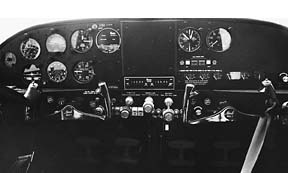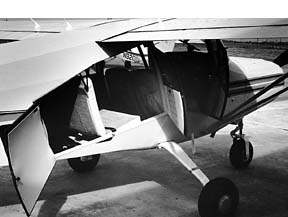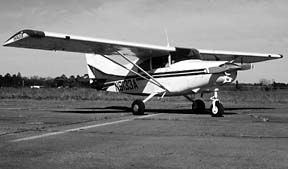It may not be sleek, sexy or fast, but the relatively new Maule MXT-7-180 does deliver typically good Maule short-field performance for a relatively low price, while leaving the bugaboo of taildragger ground handling behind.
The tri-gear Maule is the companys first attempt at direct competition with mainstream four-place, fixed-gear singles. Introduced in 1991, at about the same time as the AGAC Tiger, the airplane didnt exactly turn the industry around…but then, no design has done all that well; the days of producing hundreds of airplanes a year are long gone. It bears noting that Maule is still in business, and still producing MXT-7-180s, while AGAC is history.
Good value
Its likely that several factors are at work in Maules modest success. One is the airplanes niche market. Compared to the similarly engined Tiger, the tri-gear Maule offers virtually identical useful load, and though its far slower, the Maule offers far better short-field performance, rate of climb, service ceiling and range (more on this later).
The other factor is price. Maule has been very aggressive with its pricing. At the airplanes introduction, a VFR version went for $79,995. Today, and average-equipped MXT-7-180 with a constant-speed prop and average equipment goes for a little over $145,000.
Still, thats not bad. To put it in perspective, the 1990 AGAC Tiger went for $88,900, and quickly increased in price to over $100,000, with the last leaving the doors with a $129,800 base-price sticker attached, and an average equipped cost of a whopping $166,238. The 1990 Piper Archer II cost $91,900 base, and now costs (ahem) more than $200,000 with an average equipped price in excess of $180,000. Even the Diamond Katana, a futuristic VFR-only two-place trainer, costs over $100,000.
The company advertises that the price savings from the nearest competitor could pay for all fuel to TBO (2000 hours). Thats a pretty good value for a new airplane.
As a side note, the equivalent taildragger Maule-the MX-7-180B-costs about $9,500 less than the tri-gear. Though 160-HP and 235-HP variants are available with and without constant-speed props, this report will concentrate on the 180-HP, constant-speed, tri-gear Maule.
Construction
What you get for your money is an airplane not terribly different from its taildragger siblings, with a tube-and-fabric fuselage and metal wings and stabilizer. Metal also covers the forward part of the fuselage, from the aft edge of the doors on up.
The landing gear is, of course, significantly different. Instead of the taildraggers shock-absorber equipped main gear and steerable tailwheel, the tri-gear airplane has an aluminum leaf-spring main gear, with an oleo-strut nose gear.

Interestingly, the nose gear does not detract from performance…the conventional gears shock absorbers add about the same amount of drag as the nose gear. Optional partial wheel fairings are available.
The fuselage is covered with Ceconite, which can last as long as 20 years with proper care. Its unlikely that any tri-gear Maule has yet seen enough service for the fabric to have degraded seriously, but it doesnt hurt to check.
The tri-gear Maules wing is about three feet longer than that found on the taildragger MX-7. Essentially, its the same wing found on the M-6. The extra span allows Maule to put longer span ailerons and flaps on the trigear airplane.
The hardware used on the airplane is simple, inexpensive and utilitarian. This gives it much less of a polished, finished feel than some other airplanes, but it does get the job done. It depends on how you look at it…itll strike you as either cheap and rinky-dink, or simple and no-nonsense. The use of simple, off-the-shelf components also means that replacement parts are much, much less expensive than those for the average Beech, Piper or Cessna, and you cant argue with that.
Creature comforts
Getting in a Maule isn’t exactly the easiest thing in the world. True, other airplanes require the pilot to crawl around the cockpit to a degree, but hoisting yourself up into the seat of a Maule takes a bit of doing: there is a certain technique, which involves putting your feet in the right place and grabbing the right tube inside the cockpit.
The back seats are better. There’s a nice, big back door, which makes access to the rear relatively easy, especially if youre tall. Further, the baggage door is a clamshell mate to the back door, and when both are open there’s a great, gaping hole in the right side of the airplane.

When the rear seats are folded up, there’s a large cargo area made available. A nice feature is that when folded, the rear seats are suspended from the ceiling, leaving a hard, flat floor to stow cargo in: sensible.
To get this sort of cabin access in another brand of airplane, its necessary to go a step or two up, into the Cherokee Six/Skywagon class.
The plethora of doors-everybody has one except the right-rear passenger-is a good feature when it comes to crashworthiness. There is no perfect design, of course, but the more exits, the better, in our opinion.
In the cockpit, inertia-reel harnesses are standard, though they may need to be adjusted. On the Maule we looked at, one of the lap-belt straps was too long, which left the shoulder harness improperly located. there are two angled struts obstructing the windshield, though overall visibility is no worse than a typical Cessna-i.e., very good downwards, very poor when trying to look into a turn.
The panel layout is straightforward and simple, with no real surprises. Standard T-layout of the instruments to the left, vernier engine controls above a row of good-quality rocker switches in the center below the radio stack, and engine gauges on the right. We prefer to have the engine gauges closer to the line of sight, but there’s nothing terribly wrong with the Maule layout. No padding is provided.
A stall warning light is provided, with a horn optional. We recommend the horn.The flaps are manual, activated by a long lever on the floor with a spring-loaded latch in the end, a design we like. You count the number of clicks to tell where the flaps are set. Simple, direct, and largely trouble-free. Somewhat unusual is the fact that the flaps are reflexed (i.e., they are deflected up) seven degrees when the flap handle is all the way down. This cuts induced drag, and is recommended for cruise flight.
Unlike many aircraft, the Maule seems better suited to shorter pilots. For example, one of our editors is 57″, and routinely must sit on booster cushions in most aircraft, but not in the Maule. The editor we sent to fly in the tri-gear Maule is 62″, and had to move the seat full-aft in order to fit. Once there, though, the seats are comfortable. The rear seats have plenty of room, a refreshing change from other airplanes.
Reported noise level in the Maule is high, making the use of good headsets a must. Some owners also say that the cabin is a bit drafty.
Fuel system
The Maule fuel system could be better, in our opinion. Unlike the utterly simple Cessna system, the Maule has four tanks, two 20-gallon mains and a pair of 15-gallon auxiliaries. (This setup is standard on the tri-gear model, optional on the taildraggers.)
The system has seven sump drains: one for each tank, plus one per side at the system low point, plus the gascolator drain, which is hard to get to. Youre likely to have 100LL running down your arm if youre not careful. At least you don’t have to crawl under a low wing to get at them.
Fuel is drawn only from the mains, so its necessary to transfer from the auxiliaries when there’s room in the mains. This is done by a pair of transfer pumps, which are activated from switches in the cockpit.
The two sides of the system can be run independently. When the pump is on, the switch is lit (thats good), and the pump is a design that will not burn out if run dry (thats better). The pumps run at 0.4 GPM.
The catch is that the pumps don’t automatically shut off when the mains are full, nor does the excess fuel go back to the aux tank; it goes overboard. This means careful monitoring of the transfer is necessary.
It also means that unless the pilot wants to micro-manage the transfer, the mains have to be three-quarters empty before the transfer starts, and that means there will be a lot of weight, far out in the wings, making for ponderous handling.
Not only that, but if a pump fails, or the electrical system fails, all of a sudden the pilot will find that hes carrying around a lot of unusable fuel.
One pilot told us, On the plus side, it gives you something to do on long trips.
The fuel selector has the virtue of having a BOTH position, and it offers positive detents. However, there’s no positive lock to prevent the pilot from accidentally shutting the fuel off (it happens), and the handle doesnt point to the tank in use…a tiny pointer opposite the handle does. Not a really big problem if you fly the airplane a great deal, but something to consider if others who are less familiar take it up.
In flight
In our experience, the Maule lives up to its short-field credentials pretty well. We flew it on a close-to-standard day with two aboard, and the airplane left the ground in short order, and at a surprisingly low airspeed (about 30 or 35 knots) using two notches of flaps. Climb at Vy was 1200 feet per minute, better than the published specs for the weight. Climb at Vx (65 knots) was impressively steep, and was no problem at the weight we flew even with full flaps.
The factory pilot said that normal short-field technique is to accelerate to Vx, dump full flaps and rotate. This reputedly results in a takeoff over a 50 foot obstacle of 600 feet at gross on a standard day. (The manual, such as it is, doesnt have niceties like performance charts, and there was no way to accurately measure the climb angle during our flight.)
The Maules short-field performance is not due to any aerodynamic trickery like that found on the Koliber or Helio Courier, but to simple brute force: Lots of power for the weight hauled, and low wing loading.
Climb brings to light the Maules unusual rudder trim. There’s a T-shaped handle that is pulled until the pilot feels no rudder pressure, then locked in place. Like most things in the Maule, its simple and effective.
Deck angle during climb was quite low, resulting in excellent visibility forward.
The Maule also has an aileron-rudder interconnect (actually an aileron-rudder trim tab interconnect), which some owners don’t like, claiming it makes the airplane feel squirelly at cruise. Control harmony in our experience isn’t bad, but the Maule is definitely more of a rudder airplane than a typical Cessna, even with the rudder interconnect taken into account.
We found low-speed handling to be quite good, with a solid feel all the way down to the break, which occurred at less than 35 KIAS. There’s little tendency for wing drop. Overall, the stall behavior seemed even more docile than a 172, though not quite on the level of a Warrior.
Maintenance
Owners have reported that Maules are largely trouble-free, and the people at the factory are pleasant to deal with. The factory is run by the Maule family, though B.D. Maule himself passed away a few years ago.As noted above, there a lots of off-the-shelf components in a Maule, which in general keeps replacement cost low.
In the past, there have been some concerns about the quality of factory paint. This appears to still be a problem, with the owner of a 1993 tri-gear that he bought brand-new calling the paint his only real gripe with the Maule. This is an area that can change from year to year, though, so it may not apply to newer airplanes. Reportedly, one of the Maule clan has been assigned the task of improving the paint on newer airplanes. Keep an eye out, and make no assumptions.
Some taildragger owners also reported problems with Maule exhaust systems, which have been reported to last about 500-600 hours, and be relatively expensive.
There’s been only one really significant AD on the Maule since the trigears introduction. Its 95-26-18, calling for inspection and possible replacement of the lift struts.
Mods, organizations
Aside from floats, we know of no mods for the tri-gear Maule, though Micro-Aerodynamics does make vortex generators for other Maules. As this is written, there’s no specific listing for the trigear variant. We highly recommend VGs, which seem to do exactly what theyre supposed to with little negative side effect.
There’s a Maule newsletter published by Dave Neumeister, 5630 Washington, Lansing, Michigan, 48911-4999. 517 882-8433.
Owner Comments
I purchased a Maule MXT-7-180 in January of 1993, new from the factory. It performs as advertised. It is simple, rugged, reliable, and with two people on board can take off and land almost anywhere. I am based in Jacksonville, Florida, but I have a business in the mountains of north Georgia and a second home in the Florida Keys. the closest airports to both areas are small and unmanned, and do not offer fuel.
I had Raymond Maule of Maule Flight install his STC for auto fuel. I simply refuel my plane at those locations using plastic five gallon gas cans. The plane seems to run better on auto fuel. With avgas I must lean the engine on taxi or it will stutter on mag check; I assume because of lead build-up.
I have made several long distance cross-country flights to Oregon and Montana. Even at maximum gross weight I have never had any trouble taking off from high-elevation runways.
I bought the airplane with extended range fuel tanks, for a total of 70 gallons. I added an S-Tec autopilot and Trimble GPS after the first trip to Montana recommend both to anyone who intends to make long cross country flights.
I have most of my maintenance done by Maule Flight. they should not be confused with the company that builds the plane, Maule Air. Maule Flight is a friendly, family business operated by Ray and Ragunda Maule and their son-in-law, Kit. They are located about a half mile away from Maule Air on the same airport, Spence Field in Moultrie, Georgia. Ray and Kit rebuild Maules, do annuals and offer flight instruction.
Historically the rebuilt airplanes that have come out of Rays shop look better than the factory planes, due to the attention and process that Kit applied in the paint operation. this leads me to my only real gripe with my airplane. I have had minor paint problems with my plane almost from the beginning. Compared to Rays planes, the paint seems to be less flexible. It chips and cracks easily. I have had to constantly touch up the blemishes to keep the plane looking nice. I understand that Raymond has been assigned the task of fixing the paint problem at Maule Air since his father, Bedford, passed away several months ago.
My plane performs closely to what is published. I have 600 hours on it, and at 2450 squared, I flight plane 115 knots and 10.5 gallons per hour.
My average annual is about $900. the only real repairs so far have been welding up small cracks in the exhaust system. The insurance costs about $1400 per year.
I have had a few problems with the engine. One valve guide and the starter solenoid needed to be replaced. Im sure that Raymonds shop, during annuals, has accomplished some preventive maintenance that would have gone unnoticed with a less-experienced shop.
To sum up the MXT-7-180 here are some pros and cons:
Pros: It is truly a STOL aircraft. It can carry about 1100 pounds of fuel, people and cargo. It has a huge back cargo door that allows you to load about anything. It is economical, especially if you use auto gas. it has a rugged landing gear that allows you to land at almost any field. It is simple to preflight, fly and maintain. With the extended-range tanks, you can fly longer than you can physically hold out.
Cons: the paint is not as durable as it should be. The plane is relatively slow. The cockpit is a little drafty.
-William H. Rogers
Jacksonville, Fla.
Also With This Article
Click here to view charts for Resale Values, Payload Compared and Prices Compared.
Click here to view the Maule MXT-7-180 features guide.





